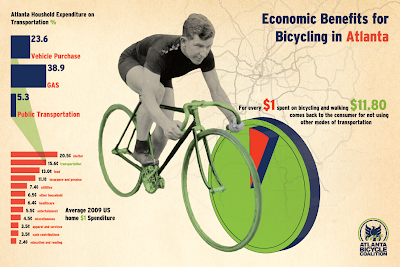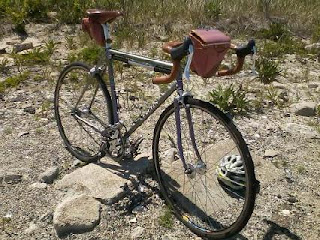Ever since I took my first bike tour in Europe, I've dreamt of the day when Americans had the sort of freedom of choice in transportation that many Europeans have.
(Of course, I was dreaming, at least for a time, of living in Europe for the rest of my life. Sometimes I still have that dream.)
Is the United States any closer to being a country where you can decide whether you want to drive, take a train or bus, pedal or walk to work, school or shop than it was in 1980? I'd say that in most of the country, that answer is "no".
I'm well aware that the number of bicycle commuters has increased exponentially over the past decade or so in my home town, New York City. Such a scenario has also unfolded in a few other large American cities, such as Boston, San Francisco, Philadelphia, Washington DC and, from what I hear, Chicago. Perhaps even more to the point, in those cities, and perhaps a few other places in the States, there are more than a few people who ride to the office or classroom or store by choice, not because they can't afford a car.
However, in large swaths of this nation, cycling and walking--or even mass transit--is less feasible than driving for most people. That is the situation even in some of our largest cities, such as Los Angeles, Denver, Phoenix and pretty much any major metro area in Florida or Texas. And, for a variety of reasons, it doesn't seem that things will change much in the near future.
What I've said in the previous two paragraphs basically sums up a recent post in a blog I've just discovered: Rebuilding Place in the Urban Space. The blog's author, Richard Layman, is "an urban/commercial district revitalization and transportation/mobility advocate" based in Washington DC. He's also a principal in BicyclePASS, a bicycle facilities integration firm.
Mr. Layman succinctly gives the most basic reason why getting to work in any way besides a car isn't really an option for most Americans: Patterns of development outside the older cities made the private automobile the fastest and most efficient way of getting around. And, where anything resembling a mass transit system was developed, it wasn't made to facilitate everyday life. An example of too many transit systems' lack of efficacy can be seen in that in places like the Tampa Bay area, even pro-transit public officials don't use the local bus system.
Even in the cities where, as I've mentioned, the number of commuters who pedal, walk or take the train or bus is growing, there are still many who choose to drive. Some simply enjoy driving or don't want to give up the sense of privacy they have in their cars. And, to be fair, some people--such as self-employed contractors--have to haul around lots of equipment or have to travel between work sites that aren't close to mass transit lines. But there are still many people who would simply prefer not to give up the freedom or privacy they believe they have in their own automobiles. Also there are still people in New York and other cities who believe that bicycles and mass transit are "for other people".
Cities like New York, Boston, Chicago and San Francisco all have transportation infrastructures--and even a few bike lanes--that have survived, mostly intact, the century or so of the automotive age. (The San Francisco Bay Area's BART system was built in the 1970's, but San Francisco, at least, had a decent transit system and something like a bicycling infrastructure before that.) They also have business and residential areas that are close to each other. In contrast, places like Tampa Bay, much of which was undeveloped during the time the older cities were building their transit systems, developed in a more horizontal way than the older cities and didn't build mass transit systems or even facilities amenable to cyclists or pedestrians.
There are some other older cities, like Detroit, Pittsburgh, St. Louis and Cleveland, had decent transit systems--or at least, housing and employment centers relatively close to each other. But, according to Layman, they "lost their ability to support sustainable transportation" as "metropolitan areas sprawled and businesses left the city", trends accelerated by de-industrialization.
I am not familiar with the transportation systems of those cities. But, if they're anything like the ones I've used in the US, they are designed to get people in and out of a central business area of the city--or, at least, some place that was a central business area at the time the system was built. Such systems aren't made to get people between destinations in the outer boroughs or suburbs.
(Given these facts, it will be interesting to see how cities like Portland, Seattle and Los Angeles-- all of which are more spread-out than New York, Boston or San Francisco--re-develop their transit systems.)
In suburban and exurban areas, it's considered a "given" that people will have cars. In fact, we now have at least a generation of people who know, basically, no other means of transportation: They have no experience with mass transit and the bicycle--if it's ridden in adulthood--is seen as a recreational, rather than a transportation, vehicle. Moreover, homeowners don't want sidewalks built across their front lawns.
From the ranks of such people come many elected representatives, who don't see the need for mass transportation or amenities that would facilitate and encourage cycling and walking. Thus, they don't vote to fund such things or even Amtrak.
Seeing the things I've described, Layman says--and he makes a lot of sense to me--it's unlikely that most transportation systems will be repatterned to make walking, cycling or public transportation practical alternatives for getting to work or wherever else people need to be. At least, it doesn't seem likely for a few more decades.
(Of course, I was dreaming, at least for a time, of living in Europe for the rest of my life. Sometimes I still have that dream.)
Is the United States any closer to being a country where you can decide whether you want to drive, take a train or bus, pedal or walk to work, school or shop than it was in 1980? I'd say that in most of the country, that answer is "no".
I'm well aware that the number of bicycle commuters has increased exponentially over the past decade or so in my home town, New York City. Such a scenario has also unfolded in a few other large American cities, such as Boston, San Francisco, Philadelphia, Washington DC and, from what I hear, Chicago. Perhaps even more to the point, in those cities, and perhaps a few other places in the States, there are more than a few people who ride to the office or classroom or store by choice, not because they can't afford a car.
However, in large swaths of this nation, cycling and walking--or even mass transit--is less feasible than driving for most people. That is the situation even in some of our largest cities, such as Los Angeles, Denver, Phoenix and pretty much any major metro area in Florida or Texas. And, for a variety of reasons, it doesn't seem that things will change much in the near future.
What I've said in the previous two paragraphs basically sums up a recent post in a blog I've just discovered: Rebuilding Place in the Urban Space. The blog's author, Richard Layman, is "an urban/commercial district revitalization and transportation/mobility advocate" based in Washington DC. He's also a principal in BicyclePASS, a bicycle facilities integration firm.
Mr. Layman succinctly gives the most basic reason why getting to work in any way besides a car isn't really an option for most Americans: Patterns of development outside the older cities made the private automobile the fastest and most efficient way of getting around. And, where anything resembling a mass transit system was developed, it wasn't made to facilitate everyday life. An example of too many transit systems' lack of efficacy can be seen in that in places like the Tampa Bay area, even pro-transit public officials don't use the local bus system.
Even in the cities where, as I've mentioned, the number of commuters who pedal, walk or take the train or bus is growing, there are still many who choose to drive. Some simply enjoy driving or don't want to give up the sense of privacy they have in their cars. And, to be fair, some people--such as self-employed contractors--have to haul around lots of equipment or have to travel between work sites that aren't close to mass transit lines. But there are still many people who would simply prefer not to give up the freedom or privacy they believe they have in their own automobiles. Also there are still people in New York and other cities who believe that bicycles and mass transit are "for other people".
 |
| Corner of Delancey and Essex Streets, Lower East Side, New York |
Cities like New York, Boston, Chicago and San Francisco all have transportation infrastructures--and even a few bike lanes--that have survived, mostly intact, the century or so of the automotive age. (The San Francisco Bay Area's BART system was built in the 1970's, but San Francisco, at least, had a decent transit system and something like a bicycling infrastructure before that.) They also have business and residential areas that are close to each other. In contrast, places like Tampa Bay, much of which was undeveloped during the time the older cities were building their transit systems, developed in a more horizontal way than the older cities and didn't build mass transit systems or even facilities amenable to cyclists or pedestrians.
There are some other older cities, like Detroit, Pittsburgh, St. Louis and Cleveland, had decent transit systems--or at least, housing and employment centers relatively close to each other. But, according to Layman, they "lost their ability to support sustainable transportation" as "metropolitan areas sprawled and businesses left the city", trends accelerated by de-industrialization.
I am not familiar with the transportation systems of those cities. But, if they're anything like the ones I've used in the US, they are designed to get people in and out of a central business area of the city--or, at least, some place that was a central business area at the time the system was built. Such systems aren't made to get people between destinations in the outer boroughs or suburbs.
(Given these facts, it will be interesting to see how cities like Portland, Seattle and Los Angeles-- all of which are more spread-out than New York, Boston or San Francisco--re-develop their transit systems.)
In suburban and exurban areas, it's considered a "given" that people will have cars. In fact, we now have at least a generation of people who know, basically, no other means of transportation: They have no experience with mass transit and the bicycle--if it's ridden in adulthood--is seen as a recreational, rather than a transportation, vehicle. Moreover, homeowners don't want sidewalks built across their front lawns.
From the ranks of such people come many elected representatives, who don't see the need for mass transportation or amenities that would facilitate and encourage cycling and walking. Thus, they don't vote to fund such things or even Amtrak.
Seeing the things I've described, Layman says--and he makes a lot of sense to me--it's unlikely that most transportation systems will be repatterned to make walking, cycling or public transportation practical alternatives for getting to work or wherever else people need to be. At least, it doesn't seem likely for a few more decades.















